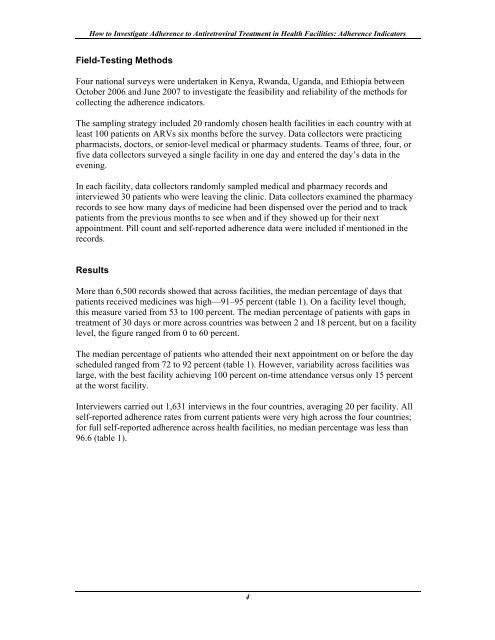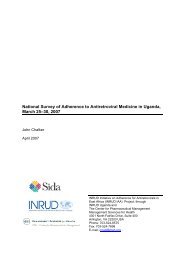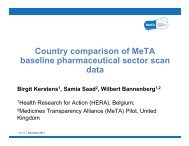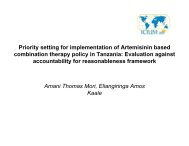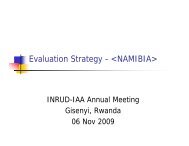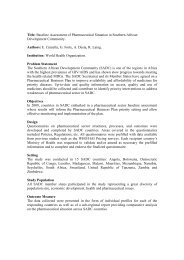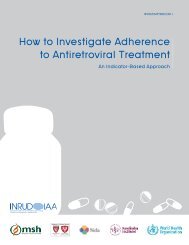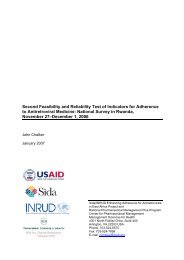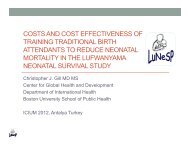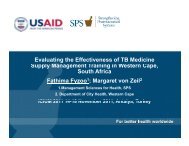How to investigate Adherence to Antiretroviral Treatment ... - INRUD
How to investigate Adherence to Antiretroviral Treatment ... - INRUD
How to investigate Adherence to Antiretroviral Treatment ... - INRUD
You also want an ePaper? Increase the reach of your titles
YUMPU automatically turns print PDFs into web optimized ePapers that Google loves.
<strong>How</strong> <strong>to</strong> Investigate <strong>Adherence</strong> <strong>to</strong> <strong>Antiretroviral</strong> <strong>Treatment</strong> in Health Facilities: <strong>Adherence</strong> Indica<strong>to</strong>rs<br />
Field-Testing Methods<br />
Four national surveys were undertaken in Kenya, Rwanda, Uganda, and Ethiopia between<br />
Oc<strong>to</strong>ber 2006 and June 2007 <strong>to</strong> <strong>investigate</strong> the feasibility and reliability of the methods for<br />
collecting the adherence indica<strong>to</strong>rs.<br />
The sampling strategy included 20 randomly chosen health facilities in each country with at<br />
least 100 patients on ARVs six months before the survey. Data collec<strong>to</strong>rs were practicing<br />
pharmacists, doc<strong>to</strong>rs, or senior-level medical or pharmacy students. Teams of three, four, or<br />
five data collec<strong>to</strong>rs surveyed a single facility in one day and entered the day’s data in the<br />
evening.<br />
In each facility, data collec<strong>to</strong>rs randomly sampled medical and pharmacy records and<br />
interviewed 30 patients who were leaving the clinic. Data collec<strong>to</strong>rs examined the pharmacy<br />
records <strong>to</strong> see how many days of medicine had been dispensed over the period and <strong>to</strong> track<br />
patients from the previous months <strong>to</strong> see when and if they showed up for their next<br />
appointment. Pill count and self-reported adherence data were included if mentioned in the<br />
records.<br />
Results<br />
More than 6,500 records showed that across facilities, the median percentage of days that<br />
patients received medicines was high—91–95 percent (table 1). On a facility level though,<br />
this measure varied from 53 <strong>to</strong> 100 percent. The median percentage of patients with gaps in<br />
treatment of 30 days or more across countries was between 2 and 18 percent, but on a facility<br />
level, the figure ranged from 0 <strong>to</strong> 60 percent.<br />
The median percentage of patients who attended their next appointment on or before the day<br />
scheduled ranged from 72 <strong>to</strong> 92 percent (table 1). <strong>How</strong>ever, variability across facilities was<br />
large, with the best facility achieving 100 percent on-time attendance versus only 15 percent<br />
at the worst facility.<br />
Interviewers carried out 1,631 interviews in the four countries, averaging 20 per facility. All<br />
self-reported adherence rates from current patients were very high across the four countries;<br />
for full self-reported adherence across health facilities, no median percentage was less than<br />
96.6 (table 1).<br />
4


